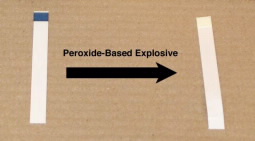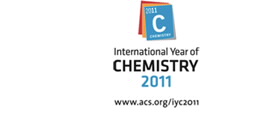EMBARGOED FOR RELEASE | March 31, 2011
New nanomaterial can detect and neutralize explosives
Note to journalists: Please report that this research was presented at a meeting of the American Chemical Society
ANAHEIM, March 31, 2011 — Scientists today described development and successful initial tests of a spray-on material that both detects and renders harmless the genre of terrorist explosives responsible for government restrictions on liquids that can be carried onboard airliners. They reported on the new ink-like explosive detector/neutralizer at the 241st National Meeting & Exposition of the American Chemical Society (ACS), being held here this week.
“This stuff is going to be used anywhere terrorist explosives are used, including battlefields, airports, and subways,” said study leader Allen Apblett, Ph.D. “It’s going to save lives.”
The material is a type of ink made of tiny metallic oxide nanoparticles — so small that 50,000 could fit inside the diameter of a single human hair. The ink changes color, from dark blue to pale yellow or clear, in the presence of explosives. It also changes from a metallic conductor to a non-conducting material, making electronic sensing also possible.
Media Contact
During the meeting, March 27-31, the contacts can be reached at:
714-765-2012
Michael Bernstein
202-872-6042
m_bernstein@acs.org
Michael Woods
202-872-6293
m_woods@acs.org
This color-change feature allows the material to work as a sensor for quickly detecting the presence of vapors produced by explosives, Apblett said. Soldiers or firefighters could wear the sensors as badges on their uniforms or use them as paper-based test strips. Airports, subways and other facilities could use the sensors as part of stationary monitoring devices. The sensors could even be engineered into jewelry and cell phones, the scientist added.
The same color-changing material can also serve as an explosives neutralizer. Firefighters and bomb squad technicians could spray the ink onto bombs or suspicious packages until the color change indicates that the devices are no longer a threat, Apblett said. Technicians could also dump the explosives into vats containing the ink to neutralize them.
Apblett notes that authorities are concerned about peroxide-based explosives, made from hydrogen peroxide, which are easy to make and set off. These explosives first drew public attention in 2001, when thwarted “shoe bomber” Richard Reid tried to use one such substance as the detonator onboard a commercial airliner. In particular, they are concerned about a substance called triacetone triperoxide, or TATP, sometimes used in suicide vests and improvised explosive devices that have claimed such a toll among troops and civilians. However, current methods of detecting this explosive are ineffective, allowing the material to easily escape detection at airports and other locations.
The new ink provides a quick way to detect and test these explosives, which might be hidden in clothing, food, and beverages. The ink contains nanoparticles of a compound of molybdenum, a metal used in a wide variety of applications including missile and aircraft parts. The dark blue ink reacts with the peroxide explosives and turns yellow or clear.
When used as an electronic sensor, the highly-sensitive material is capable of detecting TATP vapors at levels as low as a 50 parts per million, equivalent to a few drops of the vapor in a small room, within 30 seconds. The same chemical reaction allows the materials to serve as an explosives neutralizer. In lab studies, the scientists showed that they could add the material to TATP or HMTD and make them nonexplosive.
“This does a really good job of neutralizing terrorists’ explosives,” said Apblett, a chemist at Oklahoma State University in Stillwater, Okla. “I’m excited to see it moving from the lab to the real world.”
The material can also improve safety at laboratories that use explosive chemicals. Recently, Apblett developed pellets containing the ink that can be added to laboratory solvents to prevent the build-up of levels of dangerous peroxides, which can cause accidental explosions. The color-changing feature allows the users of the solvents know that they are safe.
Apblett and colleagues founded a company called Xplosafe to develop and market the material. They hope to see the explosive detecting ink used in airports in as little as a year.
The scientists acknowledge funding from Memorial Institute for the Prevention of Terrorism, the National Science Foundation, Oklahoma Center for the Advancement of Science and Technology, Xplosafe, and Oklahoma State University.
###

presence of peroxide-based explosives like those
favored by terrorists.


